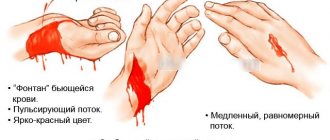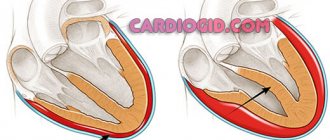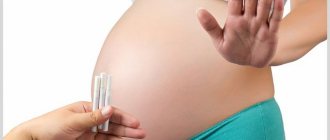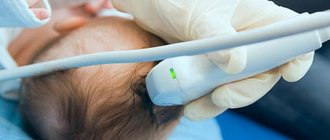A concussion is a skull injury of varying severity, which is characterized by disruption of the central nervous system (CNS). With mild damage, pressure fluctuations are not observed provided there are no underlying diseases. In case of severe injury, both an increase and a decrease in the tonometer readings are possible. Treatment requires drug intervention.
What happens to the brain when struck?
In a joint work, scientists from the United States and Sweden simulated the brain to show how it oscillates under severe impact. According to the results of the study, it became clear that the organ receives its damage not when it hits the skull, but due to compression and stretching of tissues that occur during vibrations of different frequencies.
Content:
- What happens to the brain when struck?
- Signs of a concussion
- How to Diagnose a Concussion
- How does a concussion manifest in children and the elderly?
- Treatment of concussion
- What drugs are prescribed
- Prognosis of this disease
Contrary to popular belief, the danger to the brain is not the hard skull, but the tissues themselves. For example, in boxing, during a blow to the head, the brain is injured much more than when the body suddenly stops. In addition, during a concussion, the brain is damaged to a greater extent from the inside, but the outer layer is not affected as much.
Scientists have conducted some studies in which collisions between American football players were observed. There were 189 cases in total. The players had sensors built into their helmets, with the help of which scientists were able to obtain data on the acceleration and change in the position of the head at the moment of impact.
It was found that after impacts, strong vibrations of the brain occur, the duration of which is a fraction of a second. Experts were able to sort these vibrations into frequencies, after which they found out that the strongest ones occur at a frequency of approximately 30 hertz. This can be compared to the strings of the second and third keys of a piano. Considering the situation in general, we can say that vibrations that occur with a frequency of less than 33 Hertz take 75% of the impact energy.
In addition, it was found that strong impacts provoke strong vibrations. For example, after a violent collision in which a team player fell and lost consciousness, the corpus callosum, located between the hemispheres of the brain, changed at a higher frequency than the surrounding tissue. And this led to severe deformation.
According to scientists, such modeling can be useful in the design of helmets that can suppress low-frequency vibrations that are dangerous to the brain.
Features of injury and its causes
A concussion is a consequence of a blow to the brain against the walls of the skull. Moreover, after the first contact, a second one occurs, the brain undergoes a counter-attack against the opposite wall of the skull. Being the mildest type of injury, a concussion does not lead to the death of nerve cells, but only worsens their function.
There are many reasons for injury, the main ones being:
- fall (your own height is enough);
- traffic accident;
- accident or non-compliance with safety rules at work;
- head injury due to inattention;
- blow to the head (during a fight or unanswered);
- contact sports.
It is important to understand what signs indicate a concussion and how to provide first aid to the victim so that subsequent treatment has the best result.
Signs of a concussion
Do not forget that a concussion is manifested by a disruption of its functioning. When receiving a blow, a person often loses consciousness.
Once the person regains consciousness, they will experience the following symptoms:
- rapid breathing;
- gagging and vomiting;
- fast or slow heart rate;
- memory impairment.
But, after some time, these factors disappear. Blood pressure levels also stabilize, but in some patients they may increase, and this depends not only on the injury received, but also on the severe stress experienced. It should be noted that during a concussion, body temperature does not increase.
The main signs of a concussion include:
- headache;
- nausea;
- dizziness;
- general weakness;
- flushes of blood to the face;
- noise in ears;
- increased sweating;
- insomnia.
After a concussion, a person's health improves after about a week. In rare cases, this happens after two weeks. Headache and other possible symptoms can last for a long time.
Possible complications
The consequences of a concussion can be serious if treatment is not started promptly. Failure to follow doctors' recommendations also leads to complications. Over time, the following negative consequences of the patient’s incorrect behavior appear:
- chronic headaches develop;
- post-traumatic encephalopathy occurs (dystrophic changes in brain tissue);
- memory problems are observed;
- sensitivity to weather changes develops;
- depressive states increase;
- insomnia occurs.
Severe complications include: seizures, epilepsy, dementia. Such consequences can be prevented if you regularly undergo examination by a neurologist and undergo a thorough examination as directed by a doctor.
How to Diagnose a Concussion
It is important to clarify under what circumstances the event occurred and to establish in what condition the patient is. For example, this is a negative psychological impact or alcohol poisoning.
Immediately after the injury, you may notice nystagmus, twitching of the eyelids, impaired balance and coordination of movement. Other symptoms will appear much later. The patient must be hospitalized because the symptoms of a concussion may mask other, more serious brain injuries. The neurosurgery department will conduct an examination and monitor the patient’s further condition.
So, if you receive a brain injury, you must immediately go to a medical center. There the patient will be examined by a traumatologist and neurologist. Specialists will take an X-ray of the skull to make sure there are no bone fractures. If necessary, a magnetic resonance imaging or computed tomography scan of the brain will be performed. The ophthalmologist must give his opinion. The examination results will help determine the severity of the injury. The patient is then admitted to a hospital for further treatment or prescribed a therapy regimen and sent home.
Diagnosis and treatment
To begin with, the doctor conducts a survey and general examination of the patient, and measures blood pressure. Since severe brain damage can be hidden under a concussion, it is important to monitor the patient over time. Instrumental diagnostics are required, which include:
- X-ray to rule out a skull fracture;
- echoencephalography and electroencephalography for timely detection of hidden damage;
- ophthalmoscopy - examination of the fundus of the eye.
Neuroimaging methods are considered indicative and informative. CT and MRI do not provide reliable results. If swelling is detected, they speak of a brain contusion rather than a concussion.
Treatment involves hospitalization of the patient and ensuring complete rest. Medicines are prescribed. To normalize blood pressure, Teonicol, Gliatilin, and Cavinton are indicated. Diuretics and beta blockers are necessary to prevent heart failure. To relieve headaches, "Maxilgan" and "Pentalgin" are prescribed. Nootropic drugs are prescribed to restore memory. After a concussion, a person must maintain a calm lifestyle. The state of blood pressure must be monitored throughout the course of treatment and rehabilitation. For severe fatigue syndrome (asthenia), multivitamins, eleutherococcus, and lemongrass are prescribed.
How does a concussion manifest in children and the elderly?
Symptoms of a concussion vary depending on the patient's age.
In infants and young children, when they receive a concussion, consciousness is practically not impaired. At the time of injury, you may notice pale skin, rapid heartbeat, lethargy, and drowsiness. When feeding, regurgitation occurs, vomiting occurs, the child becomes restless, drowsy, or, on the contrary, sleeps poorly. After about three to four days, all signs disappear.
Preschoolers are less likely to lose consciousness, and they recover within two to three days.
Elderly people and the elderly may also not lose consciousness, just like children. They experience disorientation in space and time. The headache becomes throbbing and occurs most often in the back of the head. The pain can last for a week, and it gets worse if the person suffers from high blood pressure and dizziness.
Pressure and shaking
A concussion is a skull injury of varying severity, which is characterized by disruption of the central nervous system (CNS). With mild damage, pressure fluctuations are not observed provided there are no underlying diseases. In case of severe injury, both an increase and a decrease in the tonometer readings are possible. Treatment requires drug intervention.
Treatment of concussion
The first aid that should be provided to the victim is as follows: the conscious person should be placed horizontally on his back and his head raised slightly.
If the patient has not regained consciousness, then he should be turned on his right side so that his face is turned to the ground. Bend your left arm and leg at an angle of 90°. Before doing this, you need to make sure that the person did not suffer bone fractures when falling. If they are present, then you cannot turn it over, but you need to urgently call an ambulance.
If everything is fine and there are no fractures, then this position of the body helps oxygen easily pass into the lungs, and excess fluid will flow out of the mouth (the tongue will not retract, and blood, saliva or vomit will not enter the respiratory tract).
If the patient has a broken head, it is necessary to apply a bandage.
As mentioned earlier, when the ambulance arrives, the person is hospitalized. Already at the clinic he is diagnosed and given the necessary therapy.
The patient is prescribed bed rest for three days. Later, taking into account the characteristics of the injury, it can be extended to five days. If after this time no complications have arisen, then the patient is discharged to continue outpatient treatment, which will last two weeks.
Features of the mode
While at home during the recovery period, the patient should remain in bed. Its duration depends on the severity of the concussion. It is important to remember that on these days the following are contraindicated:
- watching TV;
- reading books, newspapers, magazines;
- working or playing on a computer;
- long conversations.
The patient’s nervous condition is stabilized with the help of sedatives: Motherwort or Valerian tablets, Corvalol drops. The room where the person who has suffered an injury is located must be well ventilated, and the temperature must be maintained at 18-20 degrees.
Sleep is also part of successful recovery, as long as it lasts at least 10 hours a night. If photophobia is observed, then it is better to close the curtains in the room. Extraneous noise should be excluded, but pleasant relaxing music (not with headphones!) will be beneficial.
The patient may be under the supervision of an on-duty therapist if we are talking about home recovery. At the hospital, observation is carried out by a surgeon and a neurologist. In extreme cases, consultation with a neurosurgeon is required.
What drugs are prescribed
Magnesia is the most commonly prescribed medication; rest and sleep play an important role in treatment. Medicines are needed to relieve headaches, dizziness, anxiety, insomnia and other symptoms.
Best materials of the month
- Why you can't go on a diet on your own
- 21 tips on how to avoid buying stale food
- How to keep vegetables and fruits fresh: simple tricks
- How to curb your sweet cravings: 7 unexpected products
- Scientists say youth can be extended
Therefore, the patient is recommended to take painkillers, sedatives and sleeping pills (preferably in tablet form).
As a pain reliever, the following are prescribed: Analgin, Sedalgin, Pentalgin. Sedatives are: Valerian, Corvalol, Valocordin, Motherwort. The most commonly used tranquilizers are: Sibazon, Afobazol. Donormil and Relaxon will help you get rid of insomnia.
To quickly and completely restore the functioning of the brain, it is necessary to undergo a full course of metabolic and vascular therapy. In this case, it is best to combine vascular drugs with nootropic drugs (Cavinton, Glycine, Noopept).
In order to prevent the development of possible complications in time, you should undergo clinical observation for one year by a neurologist at your place of residence.
Nuances of rehabilitation
After completing bed rest and stabilizing the patient’s condition, doctors recommend undergoing a recovery course. Massage, physiotherapy, and therapeutic exercises will help return the circulatory system to normal. It will be useful to follow a diet. Among dairy products, the emphasis should be on cheeses and cottage cheese. Plant foods should be represented by an abundance of fruits and vegetables.
Despite the possible difficulties, it is better for smokers and alcohol drinkers to give up bad habits. It is recommended to limit the consumption of coffee, sweets, carbonated drinks, and reduce the amount of fatty and salty foods.
The restriction on performing heavy physical work should be at least a month; excessive mental stress is extremely undesirable. Compliance with simple rules will form the basis of a gentle regime and will allow you to quickly restore your performance.











